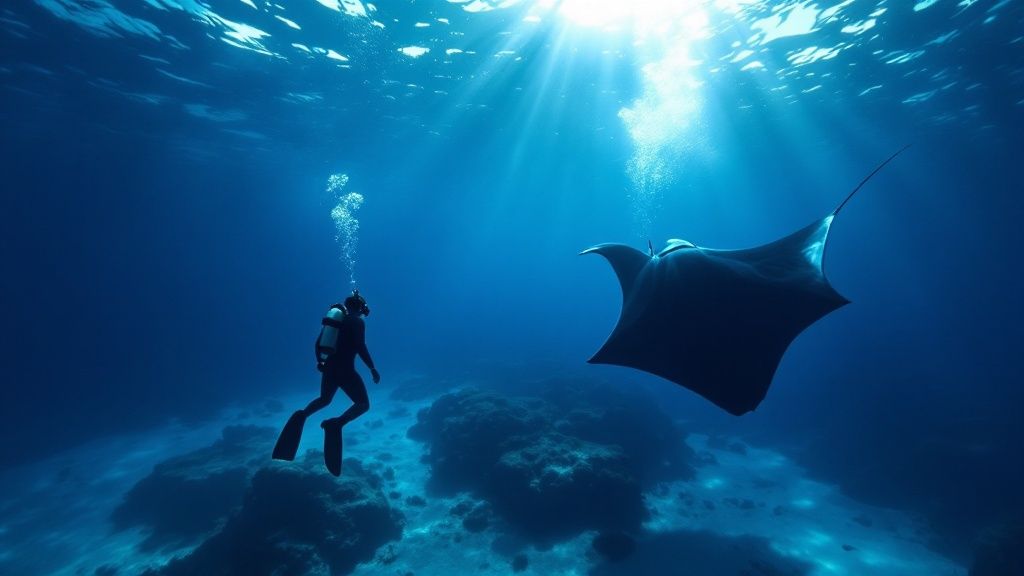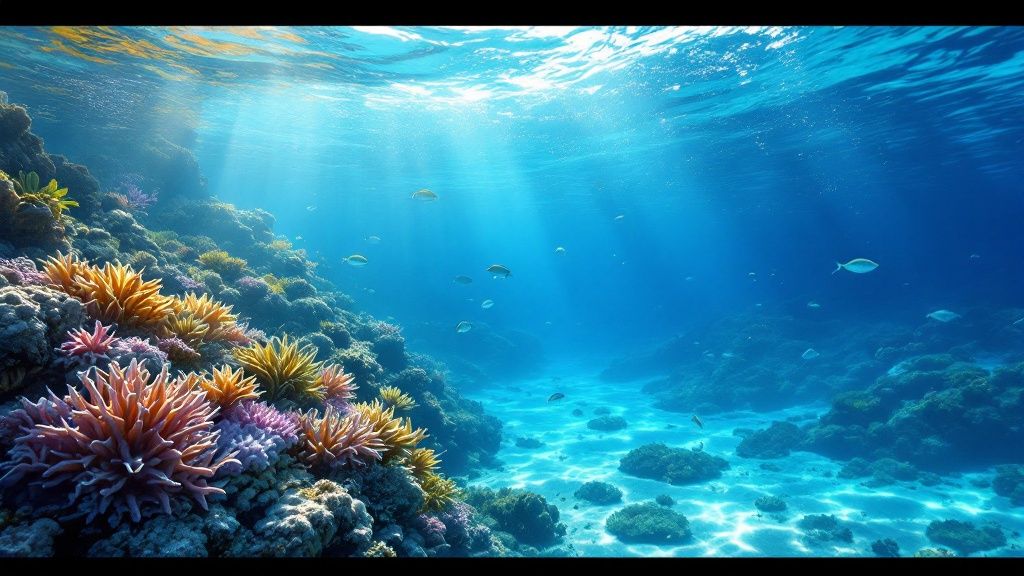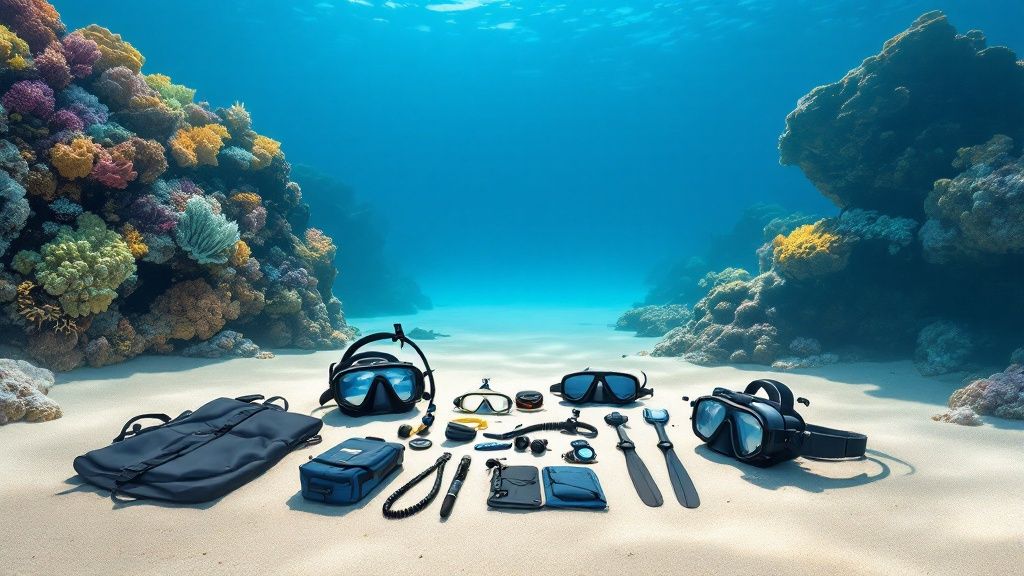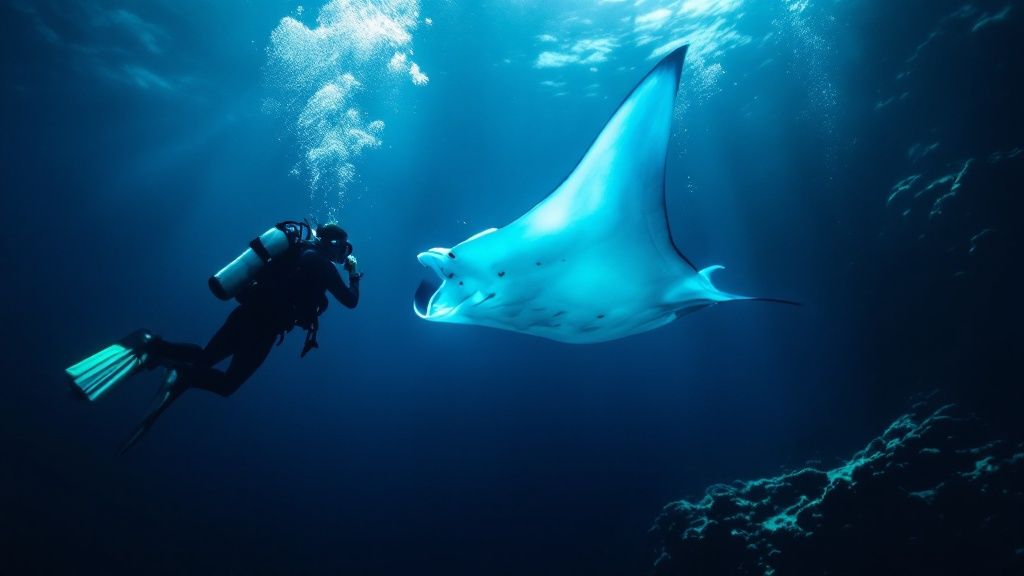The Mesmerizing World of Manta Ray Diving in Hawaii
Hawaii is a world-renowned haven for manta ray encounters, attracting approximately 80,000 visitors each year specifically to snorkel or dive with these gentle giants. This popularity stems from a unique combination of factors that make Hawaiian waters ideal for consistent and breathtaking manta ray experiences. The islands' volcanic topography creates nutrient-rich upwellings, supporting abundant plankton, the manta rays' primary food source.
This draws the majestic creatures to predictable feeding grounds, creating reliable viewing opportunities. Divers and snorkelers have a high probability of witnessing these graceful animals in their natural habitat. For tips on making the most of your dive, check out How to master the Manta Ray Night Dive in Kona with Honu Divers.
Manta Ray Hotspots: A Tale of Two Sites
Two dive sites stand out: Manta Village and Manta Heaven. Manta Village, off Keauhou, boasts a remarkable 96% sighting success rate, averaging four manta rays per dive. This consistency makes it an excellent choice for those with limited time.
Manta Heaven, near Kona International Airport, offers a different experience. While its success rate is slightly lower at 90%, it often features larger groups of manta rays, creating the potential for truly spectacular displays. Choosing between the two often involves balancing consistent sightings against the possibility of a larger gathering.
To help illustrate the differences, let's look at the following table:
Hawaii Manta Ray Dive Sites Overview: Comparing the two main manta ray diving locations in Hawaii with their success rates and characteristics
| Dive Site | Location | Success Rate | Average Mantas | Best For |
|---|---|---|---|---|
| Manta Village | Off Keauhou | 96% | 4 | Consistent Sightings |
| Manta Heaven | Near Kona Airport | 90% | Varies (Often >4) | Potential for Large Groups |
As you can see, both sites offer excellent chances of seeing manta rays, but cater to slightly different preferences. Manta Village provides reliable encounters, while Manta Heaven offers the chance to witness a larger, more dynamic spectacle. More detailed statistics can be found here.
The Magic of Night Encounters
The magic of diving with manta rays in Hawaii is amplified by the unique nighttime setting. As darkness falls, dive boats use specialized lights to illuminate the water, attracting plankton and, in turn, the manta rays. These gentle giants, with wingspans reaching up to 16 feet, glide effortlessly through the illuminated waters.
They create a mesmerizing ballet as they feed. Imagine these graceful creatures, their massive wingspans illuminated, performing acrobatic feats while feasting on microscopic organisms. This creates an unforgettable experience for divers.
It fosters a sense of wonder and connection with the marine environment. Witnessing these gentle giants up close leaves a lasting impression on those fortunate enough to share the water with them.

Prime Locations for Manta Ray Encounters in Hawaii

Hawaii Island offers incredible opportunities for diving with manta rays. Each dive site possesses unique characteristics, allowing you to tailor your experience to your specific diving goals. Let's explore what makes each location so special.
Manta Village: A Classic for a Reason
Off the coast of Keauhou lies Manta Village, renowned for its consistently high manta ray sighting rate. This makes it a perfect choice for divers with limited time or those looking for a near-guaranteed encounter. The site's underwater topography and currents create a natural plankton trap, attracting mantas for regular feeding. This results in a spectacular, almost nightly display, easily accessible from the shore.
Manta Heaven: The Potential for an Unforgettable Sight
Near Kona International Airport sits Manta Heaven, another excellent spot for manta ray encounters. While the sighting rate might be slightly lower than Manta Village, Manta Heaven often attracts larger groups of manta rays. This presents the opportunity to witness a truly awe-inspiring gathering of these gentle giants. The open-water nature of this location allows for greater freedom of movement for both divers and mantas, creating a truly immersive experience.
Garden Eel Cove & Keauhou Bay: Choosing the Right Spot
Night diving with manta rays on the Big Island primarily revolves around two distinct locations: Garden Eel Cove and Keauhou Bay. Most operators prefer Garden Eel Cove, citing an 85-90% manta sighting success rate. This is attributed to better protection from the elements, ample mooring options, and a more concentrated viewing area. You can find more detailed statistics here. Keauhou Bay, used less often, can sometimes lead to more dispersed manta ray groups, impacting sighting consistency. This underscores the importance of location and environment in maximizing your chances of an encounter.
Emerging Hotspots: A More Intimate Experience
Beyond the established dive sites, several lesser-known locations are gaining recognition. These emerging hotspots offer a more intimate manta ray experience, away from the larger crowds often found at Manta Village and Manta Heaven. These dives typically involve longer boat trips, but reward divers with the tranquility of observing manta rays in a more natural and undisturbed setting. This is ideal for experienced divers seeking a more exclusive encounter.
Finding Your Perfect Dive Site
Ultimately, the best location for your manta ray dive depends on your individual priorities. If consistency and a high likelihood of a sighting are paramount, Manta Village is your best bet. If you're willing to risk slightly fewer sightings for the chance to see a larger group of manta rays, then Manta Heaven might be perfect. For a more exclusive and serene experience, consider exploring the emerging hotspots. Local dive operators like Kona Honu Divers can offer expert advice and help you choose the ideal site for your diving experience.
Perfect Timing: When to Experience Hawaii's Manta Magic
Planning a manta ray dive in Hawaii? Strategic timing can significantly elevate your experience. By understanding the natural rhythms influencing manta ray behavior, you can maximize your chances of a truly unforgettable encounter. Interested in learning more? Check out this article: What is the best time of year to see manta rays in Kona?
Lunar Cycles and Plankton: The Manta Magnet
The lunar cycle plays a crucial role in plankton concentration, the manta ray's primary food source. During a full moon, increased light enhances plankton growth, creating a feast for these gentle giants. This often leads to increased manta ray activity around feeding sites, offering divers a higher probability of witnessing their captivating feeding dances. Conversely, a new moon can sometimes decrease plankton availability, potentially impacting sighting opportunities.
Seasonal Currents and Water Clarity: A Clear Advantage
Seasonal ocean currents also influence water clarity. During the calmer summer months, visibility tends to be optimal, allowing for clearer views of these magnificent creatures. However, winter can bring rougher seas and reduced visibility, making manta spotting more challenging. This is an important factor when planning your dive, especially for underwater photography.
Peak vs. Off-Peak: Finding Your Balance
Peak manta ray season typically coincides with the warmer months, offering increased manta activity and excellent water clarity. However, this also means larger crowds and potentially higher prices. Off-peak seasons, like spring or fall, might have slightly fewer manta sightings but offer smaller crowds, more personalized dive experiences, and potentially more affordable rates. Choosing the right time depends on your priorities. Are you willing to trade potentially fewer sightings for a less crowded, more intimate experience?
From 2009 to 2014, researchers meticulously tracked manta ray sightings along the Kona Coast, specifically at Manta Village and Manta Heaven. These records documented individual mantas, their locations, and monthly appearances, revealing crucial patterns in their behavior. This data helps divers and researchers better understand and predict manta ray movements. For more in-depth statistics, see Manta Ray Statistics.
To help you plan your trip, we've compiled some helpful data in the following table:
Seasonal Manta Ray Sighting Statistics in Hawaii
This table provides a monthly breakdown of manta ray sighting success rates, average number of mantas seen, and visibility conditions. This information is based on generalized observations and can vary based on specific conditions.
| Month | Sighting Success Rate | Average Mantas | Water Visibility | Recommended |
|---|---|---|---|---|
| January | Moderate | 3-5 | Moderate | Maybe |
| February | Moderate | 4-6 | Moderate | Maybe |
| March | Increasing | 5-7 | Good | Yes |
| April | High | 6-8 | Good | Yes |
| May | High | 7-9 | Excellent | Yes |
| June | High | 8-10 | Excellent | Yes |
| July | High | 9-12 | Excellent | Yes |
| August | High | 8-10 | Excellent | Yes |
| September | High | 7-9 | Excellent | Yes |
| October | Moderate | 6-8 | Good | Yes |
| November | Moderate | 5-7 | Moderate | Maybe |
| December | Moderate | 4-6 | Moderate | Maybe |
As you can see, the summer months offer the highest chances of seeing mantas. However, shoulder seasons can also provide rewarding experiences.

Time of Day and Weather: Seizing the Moment
While nighttime dives are the norm for manta ray encounters, the specific time can also influence your experience. Early evening, just after sunset, often sees increased manta activity as they begin their nightly feeding routines. Weather patterns also play a role. Calm seas and clear skies create optimal conditions for both surface travel and underwater visibility. Monitoring local weather forecasts and adjusting your dive schedule accordingly can greatly enhance your chances of a successful and enjoyable manta ray experience.
Essential Preparation For Your Manta Ray Diving Adventure
Preparing for a manta ray diving adventure in Hawaii involves more than just packing your swimsuit. Proper preparation significantly enhances the experience, ensuring you're comfortable, safe, and ready to fully appreciate these magnificent creatures.
Gear Up For An Unforgettable Night Dive
Standard diving gear is essential, but specialized equipment can make your manta ray night dive more comfortable and rewarding. A high-quality dive light is crucial for navigating in the dark and observing the mantas feeding on plankton attracted to the light. Consider a mask-mounted light for hands-free illumination. For extended observation periods in the cooler evening waters, adequate exposure protection is essential. A wetsuit or drysuit will keep you warm, enabling you to focus on the mesmerizing manta rays. You might be interested in: The Gear You Will Need for Your Kona Diving Adventure.

Addressing Common Concerns: Seasickness And Anxiety
If you are prone to seasickness, taking preventative measures before boarding the boat is highly recommended. Consult your doctor about appropriate medication or consider natural remedies like ginger. Night diving anxiety is another common concern, especially for less experienced divers.
Open communication with your dive master about your concerns and a thorough pre-dive briefing can significantly reduce anxiety, allowing you to enter the water feeling confident. Practicing buoyancy control in a controlled environment beforehand can also boost your confidence and enhance your overall diving experience. This preparation allows you to fully enjoy the magical encounter with manta rays without unnecessary stress.
Camera Settings: Capturing The Magic
Capturing the magic of diving with manta rays requires the right camera settings. For optimal results in low-light conditions, consider a fast lens and a high ISO setting. A red filter on your dive light can help enhance the natural colors of the manta rays and the surrounding marine life.
Experimenting with different settings before your dive will ensure you are ready to capture those breathtaking moments. This allows you to preserve the memories of this extraordinary experience long after you resurface.
Physical And Mental Readiness: Enhancing Your Experience
Maintaining an appropriate position in the water without disturbing the manta rays requires a certain level of physical conditioning. Regular swimming or snorkeling before your trip can improve your stamina and comfort in the water.
Mental preparation is just as important. Familiarize yourself with manta ray behavior and diving etiquette to enhance your comfort and respect for these magnificent animals. This mindful approach allows you to fully immerse yourself in the present moment and appreciate the unique connection with these gentle giants. Being present will magnify the impact of this unique encounter.
Mastering Night Diving Techniques for Memorable Encounters
The thrill of diving with manta rays in Hawaii isn't just about seeing them; it's about truly experiencing them. The difference between a good dive and an unforgettable one often lies in the specific techniques employed. Drawing on insights from Hawaii's top manta ray dive guides, we'll explore the nuanced skills that transform ordinary dives into truly special moments.
Buoyancy Control: The Art of Stillness
Precise buoyancy control is essential when diving with manta rays. Much like astronauts hovering in space, divers must maintain perfect neutral buoyancy to avoid disturbing these graceful animals. This means carefully adjusting your buoyancy compensator (BCD) and breathing rhythmically to hold your position in the water. Mastering this allows for longer, unobtrusive observation, letting you become a part of the underwater environment, not a disruptive presence.
Light Handling: The Gentle Glow
Proper light handling is crucial for attracting plankton without bothering the manta rays or fellow divers. Angle your dive lights upwards, creating a cone of light that draws the plankton without shining directly at the mantas. This avoids disrupting their feeding habits and minimizes stress. Think of it as setting a welcoming dinner table, not shining a spotlight in their eyes.
Understanding Manta Behavior: Reading the Signals
Learning to interpret manta ray behavior enhances the dive experience. Recognizing feeding cues, approach signals, and signs of stress allows you to anticipate their movements and respond appropriately. A manta performing a barrel roll indicates active feeding, while a sudden change in direction or rapid flapping of their cephalic fins might indicate unease. By recognizing these cues, you can respect their space and observe natural behaviors without interference. For more information on manta ray dives, check out The Big Island Manta Ray Dive.
Communication and Spatial Awareness: Navigating the Night
Night diving requires special communication. Hand signals are essential for conveying information to your dive buddy and guide. Developing strong spatial awareness is also paramount in the low-light environment. This involves maintaining a safe distance from other divers, the reef, and the manta rays. Like navigating a dark room, careful movement and clear communication are key for everyone's safety and enjoyment.
Respectful Observation: Protecting Future Encounters
These refined techniques not only enhance your diving experience but also contribute to sustainable practices that protect Hawaii's manta rays. By mastering these skills, you minimize your impact on the mantas and their environment, preserving these magical encounters for future generations. Every respectful interaction helps ensure the long-term health of these graceful giants and their fragile ecosystem. This mindful approach allows future divers to witness the same wonder and beauty.
Conservation Consciousness: Diving With Purpose
Diving with manta rays in Hawaii offers an unforgettable thrill, but it also presents a unique opportunity: connecting with these graceful creatures while contributing to their preservation. This blend of tourism and conservation is essential for the future of Hawaii's manta ray population. Every diver plays a vital role in the ongoing work to protect these gentle giants.
Your Role in Manta Ray Conservation
As a diver, your presence directly supports manta ray conservation. The tourism revenue generated by manta ray dives often funds vital research and conservation projects. Many dive operators also actively participate in citizen science initiatives, gathering essential data on manta ray behavior and population trends. This data informs conservation strategies, helping to protect the mantas and their delicate habitat. By sharing your experiences and promoting public awareness, you can inspire others to value and protect these incredible animals.
Threats to Hawaii's Manta Rays
Hawaii's manta ray populations face several threats, including fishing pressure (both direct fishing and accidental bycatch) and the far-reaching effects of climate change. Shifting ocean temperatures and increasing acidification can disrupt the manta rays' ecosystem, impacting their food sources and overall health. Furthermore, habitat degradation from coastal development and pollution presents additional challenges to their survival.
Supporting Conservation Efforts
Thankfully, local organizations are actively working to address these challenges. Groups like the Manta Pacific Research Foundation conduct crucial research on manta ray biology and ecology, informing conservation strategies. Other groups focus on public education and advocating for policies that protect manta rays and their environment. You might be interested in reading An open letter to the Hawaii State DLNR regarding Manta rules. Supporting responsible dive operators and donating to these organizations is another way to contribute to this important work.
Choosing Responsible Dive Operators
Responsible dive operators are key players in manta ray conservation. They follow strict ethical guidelines, prioritizing the well-being of the manta rays and their environment. Look for operators who emphasize small group sizes, maintain respectful distances from the mantas, and educate divers on proper interaction techniques. These operators should also actively support conservation efforts through research, education, and advocacy. This ensures your dive is not only memorable but also contributes to the long-term health of Hawaii's manta ray population.
Minimizing Your Environmental Impact
You can lessen your environmental impact during your dive through simple actions. Opt for reef-safe sunscreen, refrain from touching coral or other marine life, and dispose of any trash properly. Using reusable water bottles and reducing your reliance on single-use plastics can also make a difference. By adopting these practices, you contribute to protecting the delicate marine ecosystem that supports these gentle giants.
Extending Your Positive Impact
The positive impact of your dive shouldn't end when you leave Hawaii. Continue to support conservation organizations, share your experiences, and advocate for responsible marine tourism. By learning more and educating others about the importance of manta ray conservation, you can contribute to a brighter future for these magnificent animals. Every action, no matter how small, contributes to protecting Hawaii's manta rays for future generations.
Creating Your Ultimate Hawaii Manta Ray Diving Experience
Diving with manta rays in Hawaii is more than just a bucket list item; it's about crafting an unforgettable experience. Elevating a typical vacation dive into a truly memorable encounter requires careful planning and a focus on creating lasting memories. This means making informed decisions, from choosing the right dive operator to selecting enriching activities that enhance your overall Hawaiian adventure.
Choosing the Right Dive Operator: Beyond the Price Tag
Finding the right dive operator isn't about finding the cheapest option. Safety records, environmental practices, group size, and the operator's expertise in manta ray behavior should be your top priorities. Smaller groups often lead to a more personalized experience and minimize disturbance to the manta rays. An operator dedicated to sustainable tourism ensures your dive contributes to the health of Hawaii's marine ecosystem, making your experience even more rewarding.
Complementary Activities: Enriching Your Manta Ray Experience
Enhance your manta ray adventure by incorporating complementary activities. Daytime snorkeling or diving excursions to explore Hawaii's vibrant coral reefs and diverse marine life offer a broader understanding of the underwater world. To deepen your appreciation of Hawaiian culture, consider cultural experiences focused on the island's connection to the ocean. Connecting with local traditions adds another layer of meaning to your manta ray encounter.
Practical Considerations: Maximizing Enjoyment
A few practical considerations can greatly enhance your diving experience. Choosing accommodations near the dive sites minimizes travel time and maximizes relaxation. If you're passionate about capturing your dive, ask about underwater photography equipment rentals. High-quality photos and videos allow you to relive these special moments. Finally, develop post-dive routines to solidify your memories. Journaling, sharing photos, or simply reflecting on your experience can transform fleeting moments into cherished memories.
Integrating Manta Ray Diving Into Your Hawaii Itinerary
Integrating your manta ray dive into your overall itinerary is key. Schedule your dive early in your trip to allow for rescheduling due to weather. Consider additional dives or snorkeling trips at other locations around the islands. Hawaii boasts incredible aquatic biodiversity, from colorful coral reefs to encounters with other marine species. This creates a well-rounded marine experience showcasing Hawaii's underwater wonders. Whether you’re a seasoned diver or a beginner, diving with manta rays in Hawaii is a truly special experience. By planning carefully and prioritizing responsible practices, you'll create memories to last a lifetime.
Ready to begin your unforgettable manta ray adventure? Visit Kona Honu Divers to explore their dive offerings and start planning your ultimate Hawaiian experience.
